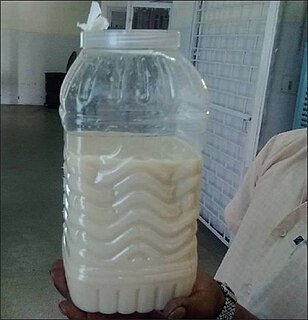 W
WBacteriuria is the presence of bacteria in urine. Bacteriuria accompanied by symptoms is a urinary tract infection while that without is known as asymptomatic bacteriuria. Diagnosis is by urinalysis or urine culture. Escherichia coli is the most common bacterium found. People without symptoms should generally not be tested for the condition. Differential diagnosis include contamination.
 W
WIn medicine, bilirubinuria is an abnormality in which conjugated bilirubin is detected in the urine.
 W
WChyluria, also called chylous urine, is a medical condition involving the presence of chyle in the urine stream, which results in urine appearing milky white. The condition is usually classified as being either parasitic or non parasitic. It is a condition that is more prevalent among people of Africa and the Indian subcontinent.
 W
WCrystalluria refers to cloudy urine when the cause of cloudiness is due to crystals found in the urine when performing a urine test. Crystalluria is considered often as a benign condition and as one of the side effects of sulfonamides and penicillins.
 W
WHematuria is defined as the presence of blood or red blood cells in the urine. An anatomical framework is helpful in developing a comprehensive differential diagnosis. Blood or red blood cells can enter and mix with urine at multiple anatomical sites. These include the urinary system, female reproductive system, and integumentary system.
 W
WHemoglobinuria is a condition in which the oxygen transport protein hemoglobin is found in abnormally high concentrations in the urine. The condition is often associated with any hemolytic anemia with primarily intravascular hemolysis, in which red blood cells (RBCs) are destroyed, thereby releasing free hemoglobin into the plasma. Excess hemoglobin is filtered by the kidneys, which excrete it into the urine, giving urine a purple color. Hemoglobinuria can lead to acute tubular necrosis which is an uncommon cause of a death of uni-traumatic patients recovering in the ICU.
 W
WHyperoxaluria is an excessive urinary excretion of oxalate. Individuals with hyperoxaluria often have calcium oxalate kidney stones. It is sometimes called Bird's disease, after Golding Bird, who first described the condition.
 W
WHyperuricosuria is a medical term referring to the presence of excessive amounts of uric acid in the urine. For men this is at a rate greater than 800 mg/day, and for women, 750 mg/day. Notable direct causes of hyperuricosuria are dissolution of uric acid crystals in the kidneys or urinary bladder, and hyperuricemia. Notable indirect causes include uricosuric drugs, rapid breakdown of bodily tissues containing large quantities of DNA and RNA, and a diet high in purine.
 W
WKetonuria is a medical condition in which ketone bodies are present in the urine.
 W
WMyoglobinuria is the presence of myoglobin in the urine, which usually results from rhabdomyolysis or muscle injury. Myoglobin is present in muscle cells as a reserve of oxygen.
 W
WProteinuria is the presence of excess proteins in the urine. In healthy persons, urine contains very little protein; an excess is suggestive of illness. Excess protein in the urine often causes the urine to become foamy. Severe proteinurina can cause nephrotic syndrome in which there is worsening swelling of the body.